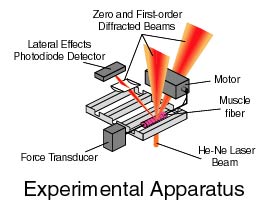
SLControl: PC-based data acquisition
and analysis for muscle mechanics
Overview
SLControl, a computerized data acquisition and analysis system developed at the Department of Physiology, University of Wisconsin-Madison, helps perform mechanical measurements on striated muscle preparations. It consists of a computer program (Windows 2000 or later) and a DAP 5216a in a PC. The package is easily installed, and already has found successful use in different laboratories. Its flexibility allows it to control a wide variety of sophisticated measurements without requiring additional analog circuitry. Physiologists, biomedical engineers and others engaged in muscle mechanics experiments may download the software at no charge from http://www.slcontrol.com for unlimited non-commercial use.
Introduction
Muscle Mechanics Analyzed in Single Experimental Stage
an “algorithm [running on the DAP board] repeatedly updates the command signal controlling the actuator position and it continually samples analog waveforms representing the overall length, tension and sarcomere length of the preparation. [It injects] negative feed back to 'clamp' any one of the acquired signals at a constant level.”
Kenneth S. Campbell, PhD, University of Kentucky
Much of our knowledge relating to the mechanical properties of biological systems has come from measurements performed using skeletal and cardiac muscle preparations. Many ingenious protocols have evolved over the years but most mechanics experiments belong to one of two distinct groups. In the first group, experiments carefully control the length of the preparation and measure the force the muscle generates. Conversely, in the second group, experiments control the tension and measure the length.
In the early days of muscle mechanics, these different types of experiment often required distinct pieces of experimental apparatus. In the first group, an elaborate servo-controlled motor attached to one end of the muscle controlled its length. In the second group, muscles pulled on appropriately loaded levers that controlled tension. SLControl combines the two approaches: it allows both types of experiment to proceed under computer control in a single experimental stage.
The schematic diagram on the right shows the experimental apparatus. A force transducer attached to one end of the muscle measures the tension in the preparation. An actuator attached to the other end of the muscle can change the preparation length. It helps in some cases as well to measure the mean length of the muscle sarcomeres (the microscopic structures that form the basic 'unit cell' of skeletal and cardiac muscles). The angular displacement of a diffracted laser beam passing through the center of the preparation makes this measurement.
The key to SLControl's flexibility is that the actuator controlling muscle length is itself under servo control. A DAPL algorithm repeatedly updates the command signal controlling the actuator position and it continually samples analog waveforms representing the overall length, tension and sarcomere length of the preparation. DAPL adjusts the actuator command signal using negative feed back to 'clamp' any one of the acquired signals at a constant level. The processing power of the DAP allows it to issue command updates at regular time intervals and to hold down response time – the gap between a measured change of state in the muscle and an appropriate corrective command. The DAP easily sustains update rates of 5kHz.
User interface
 Since SLControl delegates all time-critical tasks (including data acquisition, command output and calculations inherent to feedback control) to the DAP, the role of the PC software is straightforward. It passes commands to the DAP to define what it should do during an experiment, and it reads the acquired data back at the end of each experimental stage. Indeed, SLControl hides the complexity of the control system from the end user, who interacts with the system solely through standard Windows dialogs.
Since SLControl delegates all time-critical tasks (including data acquisition, command output and calculations inherent to feedback control) to the DAP, the role of the PC software is straightforward. It passes commands to the DAP to define what it should do during an experiment, and it reads the acquired data back at the end of each experimental stage. Indeed, SLControl hides the complexity of the control system from the end user, who interacts with the system solely through standard Windows dialogs.
Some of these dialogs allow the user to perform specific types of experiments. Others allow the display and analysis of previously acquired data. Related routines in SLControl include built-in tools for cursor analysis, digital filtering, curve-fitting, etc.
Summary
SLControl combines flexible Windows-based software and the real-time capabilities of a DAP to produce a powerful tool for muscle mechanics research. The resulting system has several advantages.
- It is relatively cheap, easy to install and simple to replicate. It requires no additional analog circuitry. Other than the experimental setup itself (force transducer, actuator etc. – which anybody engaged in muscle mechanics already will have), it requires only a PC (with installed software) and a DAP.
- The system is compatible with a wide range of commercial and custom-built instrumentation.
- SLControl can perform stable real-time control at command update rates exceeding 2.5 kHz – fast enough for all but the most demanding applications. Moreover, control can be switched between different signals (force, sarcomere length etc.) at will in the time interval between consecutively sampled points.
- The control software is extremely flexible. Windows dialogs are provided for a number of standard muscle physiology tests including rate of tension recovery measurements, force/velocity, power assessment etc. Other protocols can be developed with minimal effort.
Visit http://www.slcontrol.com for more details.
Browse other customer applications.
